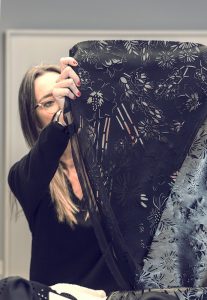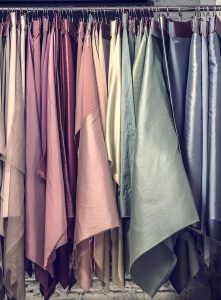
The designer’s role is essential in shaping a brand’s identity in the textile industry. Whether in-house or freelance, designers create collections that stand out, yet many companies underestimate their impact. Their work lays the foundation for a brand’s uniqueness, directly influencing product success and sales.
Let’s take a closer look at the designer’s role in setting the company’s wheel in motion—a process that begins with design and ends with the final product:
Research
This is the starting point. The designer establishes the trends that will define and shape the season, selecting those most appropriate for the brand. This process includes trips to fairs, shopping tours, visits to showrooms, and exploring fashion magazines and social media platforms (nowadays, Pinterest and Instagram are must-haves for designers).
“I need many things to feed my inspiration: objects, images, stories, and pieces of clothing. I need to see new things all the time, new places, and new people to listen to. Inspiration can come from everything, anything—photography, cinema, ballet, literature, painting, sculpture…”
—Antonio Marras, former Creative Director of Kenzo
Selection
After researching trends and gathering inspiration, the next step is selecting fabrics, colors, and trimmings. At this stage, it’s crucial to conduct a thorough analysis of prices and identify the most suitable qualities for the collection, as these are the foundational tools of our work.
By this point, mood boards (which we’ll discuss in detail soon) will already be in progress, serving as a valuable guide for making well-informed choices regarding fabrics and colors.
Drawing
Now, we begin shaping the models we envision. However, this process starts with a detailed collection plan. It’s essential to determine how many models we will produce and how they will be distributed within the collection.
For me, initial hand sketches are the fastest way to capture the essence of each mood board and visualize product development. Once we decide which models to move forward with, today’s technology offers incredible precision tools, including 3D applications. These allow us to apply prints, textures, and colors to garments, enabling us to preview the designs before starting the sample production process.
Creating Technical Data Sheets
Technical data sheets are like a chef’s recipe—they specify every detail required to achieve the desired characteristics for each garment. These include flat sketches, fabric and color choices, thread specifications, buttons, and many other details depending on the garment.
Whether production is local or outsourced abroad, a well-prepared data sheet helps minimize questions, errors, and delays.
Initially, we’ll review the garment using the correct fabric but without all the finalized details, to approve the pattern. This step typically involves a fitting, ideally with a real model. However, many companies are increasingly incorporating AI and specialized software into this process. Tools like CLO 3D, Browzwear, or Tukatech enable designers to create detailed virtual samples, apply prints and textures, and test garment fit in a digital environment. These technologies not only enhance precision but also reduce the time and costs associated with physical prototypes.
Contact and Follow-Up
In some cases, contact and follow-up with suppliers are managed by the production or purchasing department. However, in SMEs, it’s often the designer who takes responsibility for monitoring the process and ensuring that samples arrive as requested.
Consistency in following up on samples and production is crucial. Relying on chance and assuming that everything will go smoothly—that the pattern maker will perfectly interpret your intentions or that the workshop will flawlessly execute the design—is a risky approach.
It’s essential to remember that these processes are carried out by people, and human error is always a possibility. For this reason, without becoming overbearing, it’s better to secure each step of the process to ensure a successful outcome.
Gathering Information
Once the collection hits the market, the designer plays a key role in understanding how the products are being received. Analyzing sales data provides essential insights and serves as the foundation for planning the next collection.
Fashion is a wheel that never stops. 😊

